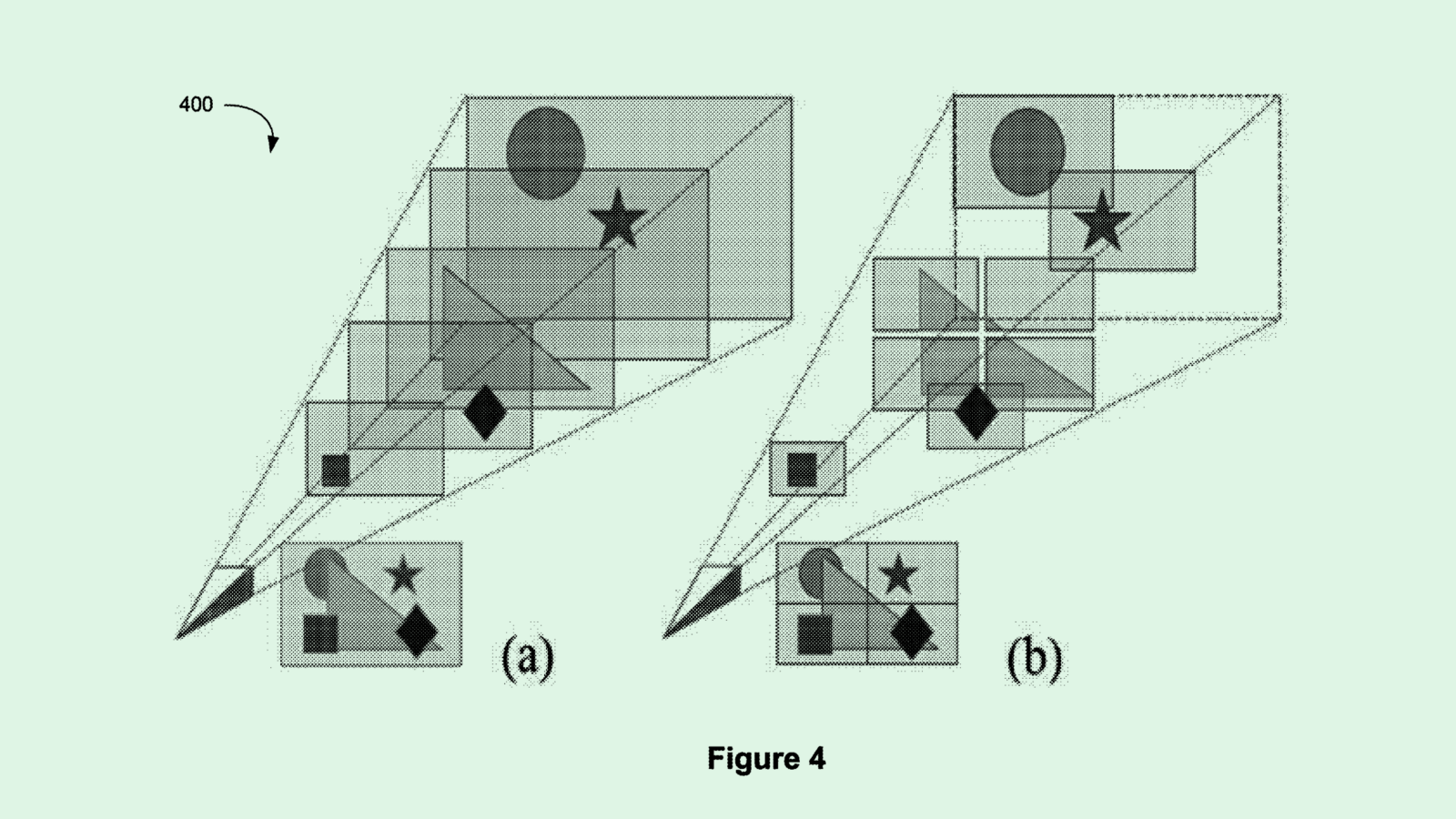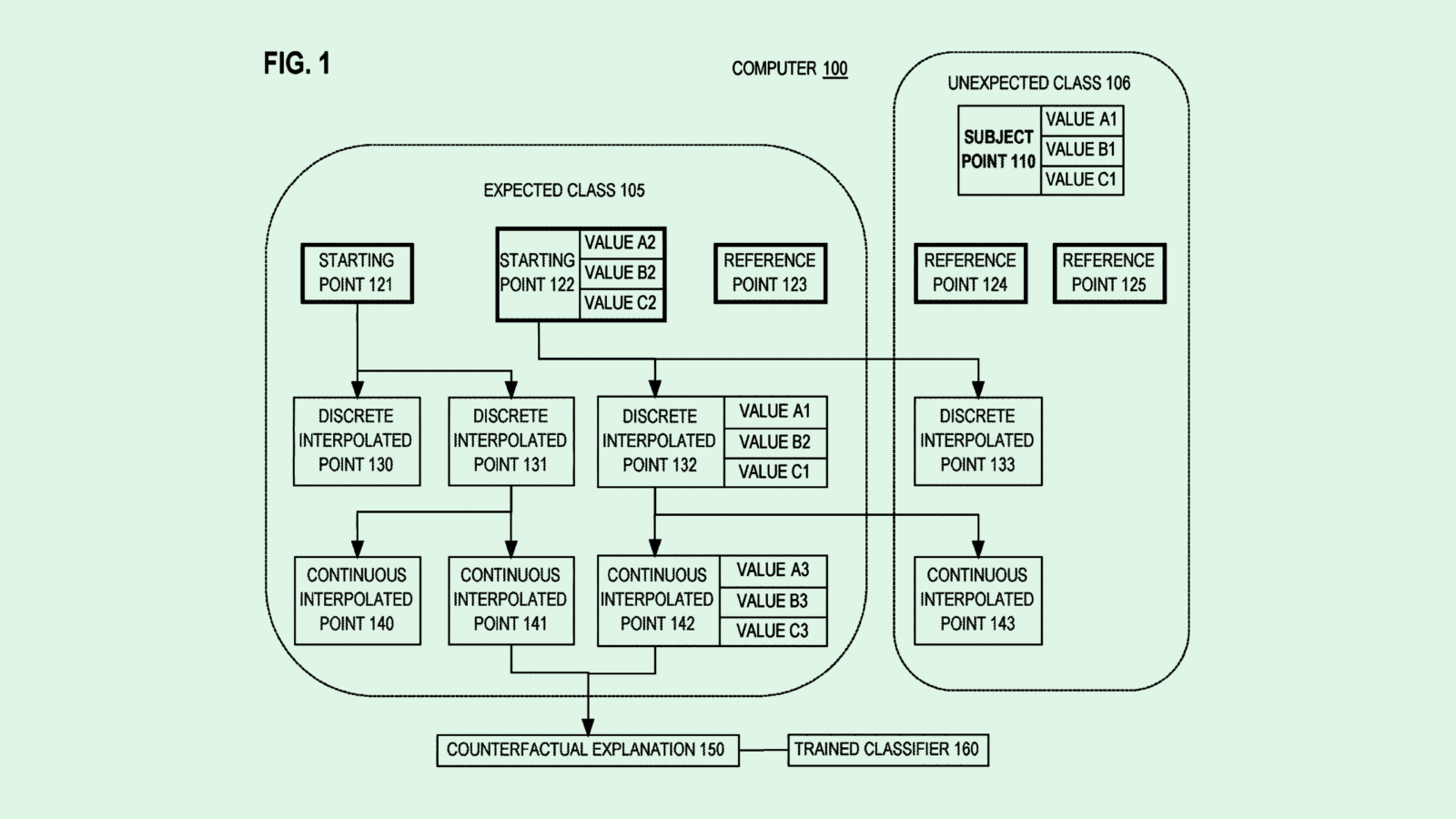Happy Monday and welcome to Patent Drop!
Today, Meta’s patent to use neural networks to slice and dice images for artificial reality hints at the use cases that AI may have in building its metaverse. Plus: Oracle plays AI catch-up as its data centers take off, and Lyft adds to its growing scooter and bike ambitions.
Let’s get into it.
Meta’s Double Vision
Meta wants to give you a deeper perspective.
The company filed a patent application for “neural view synthesis” using “tiled multiplane images.” To put it simply, Meta’s filing details a way to make 2D images more immersive in mixed-reality experiences using neural networks.
“The task of synthesizing novel views from a single image has useful applications in virtual reality and augmented reality,” Meta said in the filing. However, creating what Meta calls “view synthesis” can be difficult to do with larger images, the company said.
To do so, Meta’s tech first separates a single image into two: a “color image” and a “depth image.” The original image is also fed to a neural network to extract a “feature map,” or a representation of all of the important features within it.
Then, the feature map, color image, and depth image are broken up into a bunch of tiny corresponding “tiles,” and fed to a second neural network to create “masks.” The masks separate different images into distinct planes, such as foreground, midground, or background. All of this information is used to render the original “single plane” source image into an immersive, 3D scene.

This isn’t the first time we’ve seen Meta put AI to work in its dreams of creating a metaverse. The company has filed patent applications for AI-embedded smart glasses for people with sensory impairments, and a system similar to this patent that uses AI for artificial reality image reconstruction.
It makes perfect sense why Meta seeks to use AI for these processes, said Jake Maymar, AI strategist at The Glimpse Group. Generally, 3D-rendering of 2D data can be expensive and time-consuming, especially in the context of artificial reality. Using AI makes this process far more efficient, he said.
And if that AI rendering isn’t processed locally on the device, but via a cloud network, that opens the door for lower latency and lighter form factor — potentially signaling how the next generation of smart glasses may work, Maymar added. “I always wonder what’s next with patents,” he said. “With this one, I actually think it’s AR glasses.”
Plus, like the rest of tech, Meta continues forging ahead on the AI front. And in its quest for dominance, it is using one of its biggest assets: an astronomical stockpile of data. The company acknowledged last week that every public Instagram and Facebook post made by adults since 2007 has been leveraged to train its AI models (the only exception being EU-based users).
And while this data stands to strengthen its foundational models as it seeks to compete with Google and OpenAI, Maymar noted it can also prove incredibly fruitful in artificial reality development. Training on the massive collection of text, image, and video data can lead to AR innovations in rendering, sentiment analysis, content generation, and more, he said.
It’s akin to how Stable Diffusion by Stability AI was “basically trained on all of the internet,” and is now one of the most high-powered generative models on the market, he said. “There’s a wealth of knowledge there that they can train a model on,” said Maymar. “It’s going to be pretty sophisticated.”
Oracle Explains Itself
Oracle wants its models to be able to explain themselves.
The tech firm is seeking to patent an “autoMLX,” or automated machine learning, “counterfactual explainer.” Oracle’s invention aims to provide “counterfactual” explanations for machine learning models’ outcomes, essentially explaining why they didn’t come to other outcomes.
“The main goal of a counterfactual explanation is to help users understand why a machine learning model produced a particular inference and to aid in the decision-making process related to the inference,” Oracle said in the filing.
Though counterfactual explanation tools for AI models already exist, Oracle claims that its patent improves on conventional methods in two main ways. For one, in providing explanations as to why a model didn’t reach a certain outcome, it makes as few changes to the input as possible to showcase new outcomes.
Second, in generating those new outcomes, it ensures they are as close to the original data as possible. This is so the counterfactual explanations are actually realistic and applicable to the situation.
To illustrate how this may work in practice: Say you’re using a machine learning model to predict whether or not you will qualify for a loan. If you don’t qualify, then it may provide counterfactual, alternative examples of small changes that can be made to reach that qualification, such as small increases to income, minimal improvements to credit, or both.

Though Oracle had initially fallen behind in the AI race, its recent earnings, data center moves, and AI investments signal that it’s serious about playing catch-up. The company saw shares jump last week after it reported better-than-expected revenue, with its cloud revenue in particular rising 21% in the recent quarter.
CEO Larry Ellison also announced that it would design a data center powered by small modular nuclear reactors as AI continues to propel energy demand.
“Oracle is well-positioned to capitalize on the AI revolution, thanks to its strong foothold in database and data management,” said Tejas Dessai, research analyst at Global X ETFs. “As enterprises upgrade their data infrastructure for AI, Oracle’s expertise becomes more valuable.”
While tech giants like Microsoft, Google, and Amazon quickly gained prominence with the rise of AI, “Oracle, IBM, and other key players are following suit,” experiencing their own moment in the sun, said Dessai. However, while Oracle’s stock is popular for now, Dessai noted, it “runs the risk of expectations getting too ahead of reality.”
To continue its winning streak, he added, the company should invest in modern data tools and platforms, allowing clients to not only modernize their IT but better incorporate generative AI into their tech stacks. Methods like this patent describes could be part of that toolkit.
“Collaborating with or acquiring AI-focused startups could help Oracle quickly expand its AI capabilities and offerings,” said Dessai.
Lyft Scoots Ahead
Lyft may want to keep a closer eye on its smaller rides.
The rideshare company filed a patent application for “tandem riding detection on personal mobility vehicles.” As the title of implies, Lyft wants to make sure you’re not giving out free rides on its dime.
“A personal mobility vehicle (e.g., a scooter) may have limited hardware, low-powered, or light-weight components and tandem riding may lead to wear and tear of these components,” Lyft said in the filing.
To combat this, Lyft’s system would collect data about your “approximate load” on a scooter with embedded sensors over the course of several rides, and store that as part of your profile. It would then compare that approximate weight to the load on the scooter for any subsequent rides. If it notices during a ride that the weight on the scooter is significantly heavier, it may conclude the user is tandem riding, and notify them to stop.
Additionally, Lyft is seeking to patent for micromobility “vehicle cockpit assemblies” that include cameras. This patent describes a design for the front of both its scooters and bikes that includes a camera, meant to take photos during rides. The images captured could be used to provide user feedback on surrounding conditions, like road surface conditions and pedestrian information.

Lyft has had a slightly rocky road with micromobility. Last summer, the company considered selling off its bike and scooters unit amid layoffs and cost-cutting measures after it received interest from prospective buyers. And earlier this month, the company announced that it’s restructuring its micromobility unit, with changes aimed at “right-sizing [its] cost structure.”
The changes include layoffs that would impact around 1% of staff, research and development cost-cutting, and “focusing on deployment” (so we may see fewer patents related to Lyft’s bikes and scooters from now on). Lyft also announced that it will narrow its product portfolio to focus only on docked bikes, ebikes and scooters, rather than standalone versions, and partner with firms like Bird and Spin in the cities where it doesn’t operate.
Despite the shakeup, the company has faith in the tiny but mighty unit, with CEO David Risher telling TechCrunch in an interview that “e-bikes in particular are growing so fast globally. It would be insane not to take it on ourselves.”
Though Lyft hasn’t revealed exactly how much it makes from micromobility, Risher told TechCrunch that the company would benefit from the restructuring “on the order of $20 million a year,” and around 56.7 million of all Lyft trips in 2023 were bike or scooter rides.
Extra Drops
- Apple wants to know when you’re working up a sweat. The company filed a patent application for “automatic exercise route detection.”
- Google wants to read the room. The company is seeking to patent a way to “recognize speech without [a] transcription” using text injection.
- Honda wants to avoid fender benders. The automaker filed a patent application for a “parking lot management system.”
What Else is New?
- TikTok parent company ByteDance is stepping up its AI chip efforts, aiming for mass production of two chips the company designed by 2026.
- The FDA has approved Apple’s sleep apnea detection technology for its watches, just days ahead of the release of the upcoming model.
- Bitcoin mining has hit a record hash rate, or the level of collective computing power eaten up by all miners.
Patent Drop is written by Nat Rubio-Licht. You can find them on Twitter @natrubio__.
Patent Drop is a publication of The Daily Upside. For any questions or comments, feel free to contact us at patentdrop@thedailyupside.com.
